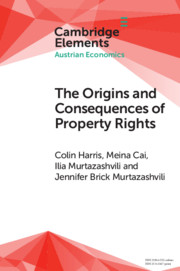Element contents
The Origins and Consequences of Property Rights
Published online by Cambridge University Press: 30 November 2020
Summary
Keywords
- Type
- Element
- Information
- Series: Elements in Austrian EconomicsOnline ISBN: 9781108979122Publisher: Cambridge University PressPrint publication: 24 December 2020
References
- 13
- Cited by

